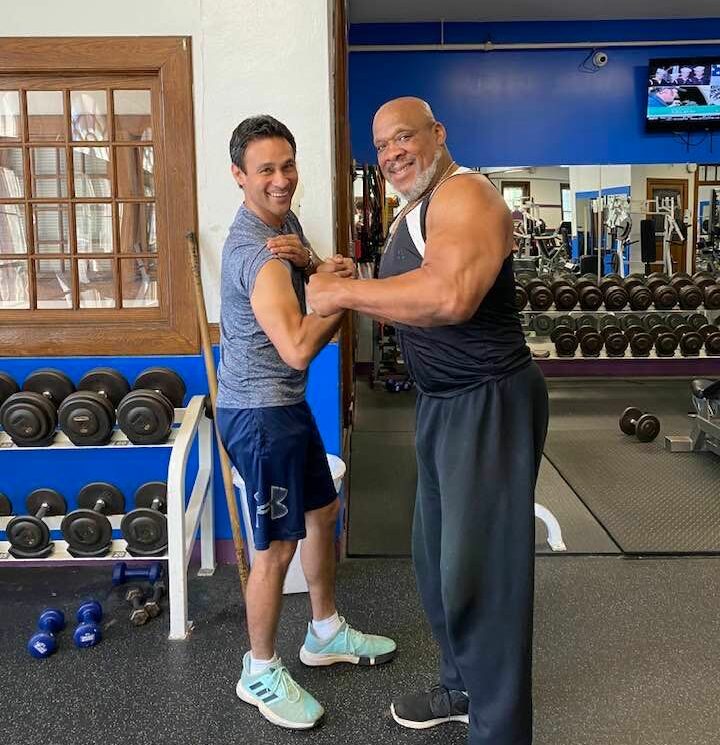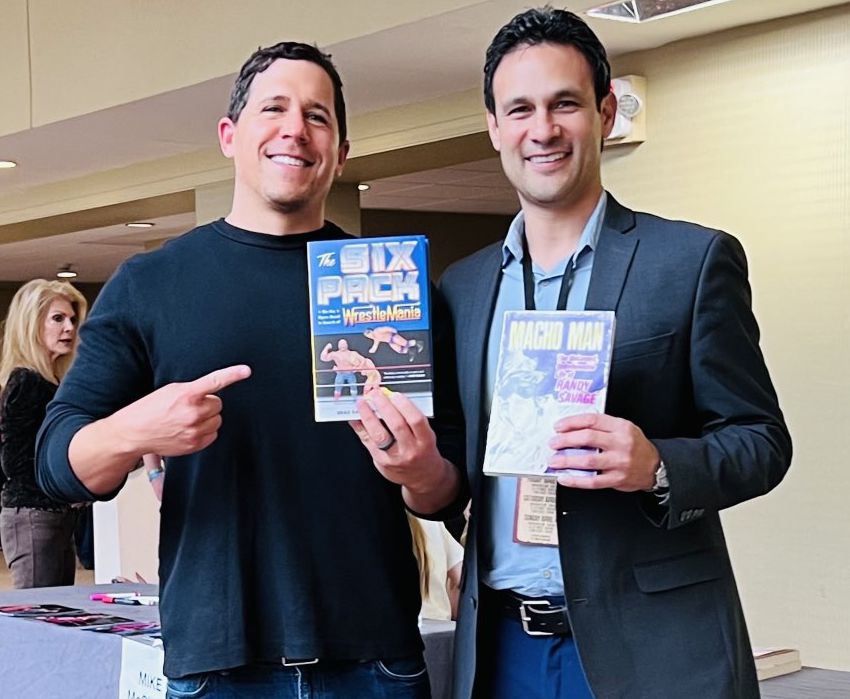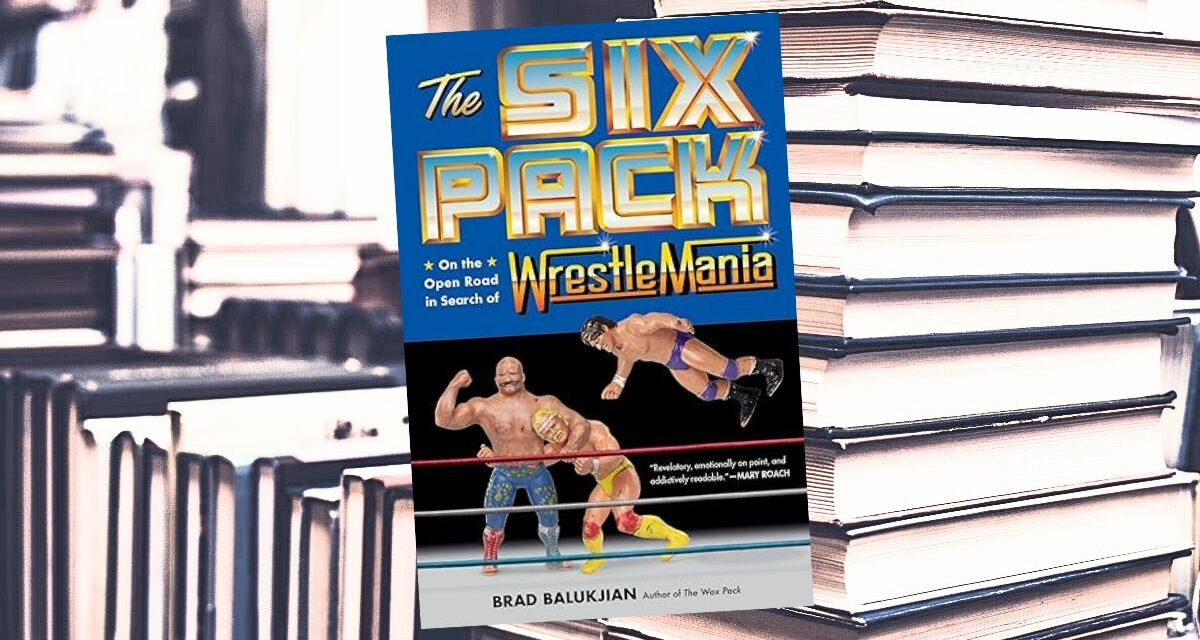In The Six Pack: On the Open Road to WrestleMania, Dr. Brad Balukjian sought a deeper understanding of the cultural phenomenon of professional wrestling by researching and interviewing The Iron Sheik, and five other men who wrestled on the December 26, 1983 WWF card wherein The Iron Sheik defeated Bob Backlund to become the new WWF champion.
The Six Pack is a strong new entry in the vast and always-growing library of books about professional wrestling. It’s accessible, and should appeal to a general audience and casual or lapsed fans, and yet it’s well-researched and breaks new ground in the subgenre of wrestling nonfiction, thanks to the literary format Balukjian essentially created in his previous book, The Wax Pack: On the Open Road in Search of Baseball’s Afterlife.
Ahead of the release of The Six Pack, I had the opportunity to talk to Balukjian on the phone, and ask some questions that had been on my mind since I finished reading his new book.
In possibly my favorite chapter of The Six Pack, Balukjian flew to Puerto Rico to interview journeyman wrestler Jose Luis Rivera, and spent some quality time with Rivera and his family. In one of the sweeter parts of the chapter, Balukjian mentions that Rivera’s 11-year-old son, Yahir, asks if he can interview him after his book comes out, and so I had to ask him if that happened. Balukjian said it did, but the question reminded him to get back in touch with Rivera and family again. Balukjian said that he and Rivera remain connected on social media, and he’ll notice when Rivera gives him a “thumbs up” on Facebook posts. Balukjian said that Yahir doesn’t speak English, so Rivera has to translate their conversations.
Balukjian said that he “wasn’t sure how people would react” to the chapter on Rivera, because there’s so little known about him, and of what is documented, there’s a lot of “conflicting or missing information.” Balukjian called it the “most anomalous chapter,” compared to the other chapters in the book, but I think that’s what made it stand out from the others. An interesting bit of information is that Balukjian practices as a scientist who studies island biology, so in a sense, that’s what his chapter on Rivera accomplishes. (His PhD is from University of California, Berkeley, Doctor of Philosophy (PhD), Environmental Science, Policy and Management.)
With Balukjian’s approach to writing, I find there’s a lot of similarity between his books and documentary films, so I asked about his creative process, and what has inspired him as an author. He said “can’t imagine writing in any other style” than his own, where he blends “personal voice with information and facts.” To his eye, in most current works of nonfiction either the writer “takes a backseat,” and the book is focused solely on research, or it’s a memoir, which tells a personal story of the author’s life. So Balukjian takes inspiration from nonfiction writers like George Plimpton, and other practitioners of participatory journalism, such as the “new journalists” of the 1960s and ’70s, like Hunter S. Thompson. Balukjian said he’s also a fan of Mark Bowden, best-known for the book Black Hawk Down, but his favorite book by Bowden is Bringing the Heat, about the 1992 Philadelphia Eagles. He said he also enjoys Bone Valley, a true crime podcast. Despite the subject matter, be it baseball players or pro wrestlers, Balukjian said he’s a “travel writer, first and foremost,” because he’s out on the road, out of his element, and the places he visits in search of his subjects “become part of the story.”
On the wrestling literary side, Balukjian was happy to share his favorites: Tim Hornbaker’s Death of the Territories; Guy Evans’ NITRO: The Incredible Rise and Inevitable Collapse of Ted Turner’s WCW, which he called “researched and comprehensive”; The Queen of the Ring: Sex, Muscles, Diamonds, and the Making of an American Legend by Jeff Leen; and Bret Hart’s Hitman.
Balukjian said one of his goals with The Six Pack was “to fill a gap in the wrestling bibliography,” and to write a book that breaks new ground in terms of the historical record, and he said he believes he was able to accomplish this by interviewing so many people who’ve never spoken on the record before, such as front office people, so he said there’s enough new information, new content, and new interviews in The Six Pack to “satisfy hardcore wrestling fans,” but it’s still accessible in the same way the general audience reacted to films like The Wrestler and The Iron Claw.
I was curious how Balukjian decided who to interview, because he mentions in the book, of the 26 men who wrestled on the December 26, 1983 card, there were 16 wrestlers who were still alive when he began the project, but he narrowed it down to six (not including Hulk Hogan and Vince McMahon). Balukjian said he knew he “couldn’t do 14,” which was how many there were in The Wax Pack. Also, this was a “cruder” concept for a book, in that it didn’t have as tidy of a concept as a pack of baseball cards. What he did have though was his personal story with The Iron Sheik, which he said could serve as “the pack,” but from there, he had to cut it down, and have a “balance of people in different parts of country,” and he wanted to make sure the interview subjects were “of sound mind.”
Balukjian did interview some wrestlers who ultimately weren’t included in the book, such as Ken Patera. He also started work on a Backlund chapter, which seems like possibly the most obvious choice for a chapter, since he was who The iron Sheik defeated the night of December 26, 1983. Balukjian did some research on Backlund and spent some time with his biographer, but once he realized he wouldn’t be able to interview Backlund himself, he decided against including that chapter, because he didn’t want too many chapters with subjects he didn’t get to talk with.

Brad Balukjian and Tony Atlas. Facebook photo
Being that Balukjian’s first two books involved researching and interviewing baseball players and then professional wrestlers, I was curious if there were any significant differences between interviewing these two groups of athletes. There were “differences and similarities,” said Balukjian, further explaining: “Wrestlers are understandably more guarded [and] very suspicious.” Other than Dwight Gooden, no other baseball player asked to be paid for their time, and with the group of wrestlers he interviewed, Tony Atlas and Tito Santana both asked to be paid. He also said the wrestlers were “more tragic” and “sobering,” and because of the “miles on their lives and bodies,” the content is heavier. With that said, he acknowledged a common theme with ballplayers and wrestlers were their struggles with fathers. Many of them came from broken families or didn’t know their dads and had “similar childhood issues.” With that in mind, Balukjian said a “common denominator” was what we all have in common: “You, me, Hulk Hogan, Dwight Gooden, all dealing with anxiety and trauma. You don’t avoid that just because you’re famous.”
Speaking of trauma, the elephant in the room, or in this book, is Vince McMahon, who receives his own chapter in The Six Pack, although Balukjian never got to interview him. In my review, I said that I thought Balukjian did an excellent job keeping up with but not dwelling on the McMahon headlines, up to and including his retirement tweet, so that it didn’t consume the book. Since so much has happened between the release of advance proof copies of The Six Pack and when the final version of the book was published, I was curious if any updates had to be made.
Balukjian clarified that there were “no changes” since advance review copies were distributed. “After [McMahon] retired, he came back, then was ousted again” and he’s now “more out than ever,” so where his career ends in the book is where he effectively ended up.
Another individual profiled in The Six Pack who Balukjian didn’t get to interview was Bob Remus, aka Sgt Slaughter, although Balukjian did briefly come into contact with Remus after he spoke at The Iron Sheik’s funeral service, which was a nice bit of closure. Still, it was a surprise that Remus was so evasive, especially considering he makes so many public appearances at fan conventions and things of that nature, so he’s not exactly a recluse. Balukjian did briefly think about approaching Remus at a public appearance, but noted that he’s experienced a “maturation process in life” that matched his books. If this was his first book, Balukjian probably would have done something like that, and approached Sgt. Slaughter at a fan convention or autograph signing, but for this book now, he said it wasn’t the right thing, tonally. Similar to Hogan, where Balukjian finds him in his karaoke bar, he could’ve sung a song and had the chance to meet Hogan, but he “was good watching from a distance.” To my eye, Balukjian comes off as more respectable and respectful because of that.

Jon Finkel and Brad Brad Balukjian trade books at WrestleCon in Philadelphia on WrestleMania XL weekend. Twitter photo
One minor detail that I had to ask about was related to something written on page 156 of The Six Pack, that Sgt. Slaughter was the only real person to ever become a GI Joe character; when I read that, I immediately thought to myself, what about Super Bowl champion and WrestleMania 2 alumnus William “The Refrigerator” Perry? Balukjian admitted he didn’t know about the “Fridge” GI Joe figure, so I hope GI Joe fanatics aren’t too upset by this omission. Funny enough, a Sgt. Slaughter cosplayer once told me about an extremely rare Rowdy Roddy Piper GI Joe that was released in 2007, but that seems like more of an exception to the rule.
In the back of The Six Pack is a QR code which takes readers to something called “The Brad Pack,” so what can we expect to see on The Brad Pack? Balukjian said The Brad Pack will include a lot of the content that didn’t make it into the final book. He said that The Six Pack only includes about 10% of the interviews he completed, so there’ll be much more of that, as well as archived WWF lawsuit files, attendance figures, gate counts, and data like how much each Coliseum Video grossed. There’ll also be photographs and actual audio from interviews that didn’t make it into the book. During his research for The Six Pack, Balukjian even received Vince McMahon Sr.’s personal planner from 1963, so we can expect to see selections from that in there, too, including what talent got paid for each show. Balukjian said there will be some free, ongoing content on The Brad Pack, but it will eventually transition into a subscription model full of exclusive content, such as long form, chapter length stories, and 8,000-10,000 word articles on single wrestlers or athletes he’s calling “Brad Pack Singles.”
In the short-term, Balukjian is focusing on developing The Brad Pack. He’s got some ideas for a third “pack”/book. “They take so much out of you,” so he’s focusing on working on the new site and promoting the book.
“A lot of people don’t realize book publishing and making it viable are so hard,” he said, “you’re only as good as your last book.” He’s very grateful to have a major publisher like Hachette Books for The Six Pack, but he still views himself as the underdog in this genre.
Balukjian said that one of the most rewarding and surreal experiences he got from writing The Six Pack was an email he received from Bret Hart, who provided the following blurb: “Perhaps one of the most truthful and enjoyable reads about my profession ever. I absolutely loved this book,” and if that doesn’t convince you to read The Six Pack, I don’t know what will.
RELATED LINKS
- Review: ‘The Six Pack’ a fun read on ’80s wrestling nostalgia
- Buy The Six Pack: On the Open Road in Search of WrestleMania at Amazon.com or Amazon.ca
- Buy The Wax Pack: On the Open Road in Search of Baseball’s Afterlife at Amazon.com or Amazon.ca
- SlamWrestling Master Book List

